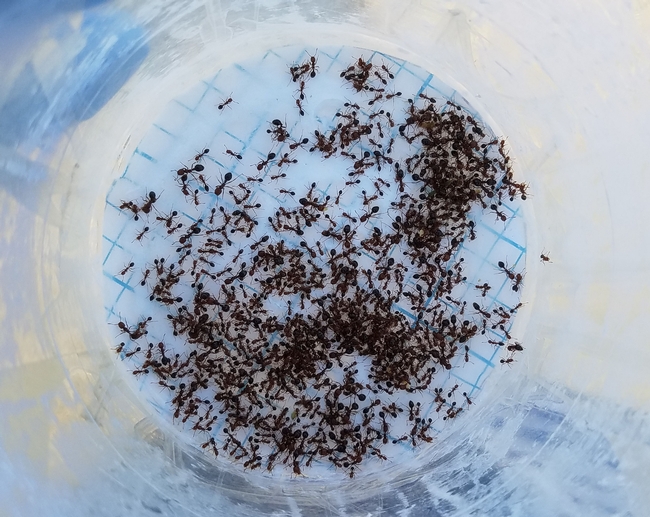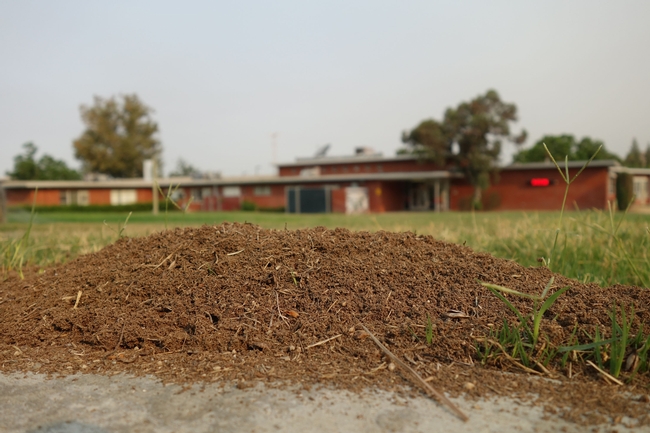- Author: Siavash Taravati
Red imported fire ant (RIFA) control routine guidelines adopted by Los Angeles County school , protecting 500 school students from stings and contributing to improved community health and wellness.
The Issue
Red imported fire ant (RIFA, Solenopsis invicta, Fig. 1) is a venomous ant that was accidentally brought into California in 1989. Since its introduction, it has spread to many new territories in Southern California and Central Valley. RIFA infests lawns on parks, cemeteries, schools, houses, farms, etc. RIFA bites and stings people and its venom may cause anaphylactic shock in susceptible individuals. RIFA is currently found in many areas in Orange, Riverside, and San Bernardino counties. It is also becoming increasingly more problematic in the Merced County. In the Los Angeles County, it occurs near the borderline of Orange and San Bernardino counties. In 2017, the California School for the Deaf in Riverside experienced a severe RIFA infestation and school's ground crew had little success in trying to control RIFA on their 70-acres of land.
How UC Delivers
Dr. Siavash Taravati, an IPM advisor at UC Cooperative Extension office in the Los Angeles County was contacted by the California Department of Pesticide Regulation about this infestation. Taravati visited the school, spoke to the grounds crew on the field, inspected infested areas for RIFA mounds, collected some ant samples for identification, and took some pictures for the study. Later, Taravati created a new pest management program to help the school management reduce the level of RIFA infestations. This study was part of a RIFA management research program and was sponsored by the California department of pesticide regulation. Four different active ingredients were used for suppressing RIFA populations. Granular insecticides were distributed using a handheld spreader or manually by hand. Construction flags and marking spray paint were used to mark areas with RIFA activity. The school was visited by Taravati 2-3 times a month for insecticide applications and monitoring the infestation levels. The project duration was one year. RIFA activity was measured prior to and after treatment. RIFA population declined drastically shortly after the onset of UCCE's RIFA management efforts. After a few months, the number of RIFA mounds in many areas was decreased by 50 percent, and ultimately up to 95 percent in some of the athletic fields that used to be one of the most heavily infested spots. Similar results were obtained in other areas with 90 percent or more reduction in the number of mounds. Even when new mounds appeared periodically on the lawn, they were often small in size. Furthermore, unlike mature and large colony mounds, only a small number of ants emerged from these new mounds when they were poked with a rod.

The Impact
The RIFA control routine guidelines were adopted by the school staff upon finding the best practices from this research. They changed their primary pesticide management method from liquid insecticide applications to using granular baits as much as possible and talked to their supervisors and asked them for more support for their RIFA management efforts. As described above, this research shows that implementing this method decreases RIFA population, thus, protecting 500 school students from stings. Research shows these stings that can cause pain and discomfort and in some cases, life-threatening anaphylactic shock requiring immediate care. In this way, this applied pest management research and extension effort contributed to improved community health and wellness.
Testimonials
School ground crew: I really want to thank you for your great help. It was nice to have help with the fire ants. There aren't many places to get free help for fire ant control. Your work helped us to protect our school kids from being bitten during your reach for sure. We really liked your method of granular bait application and adopted it for better and more efficient fire ant control. Thanks




